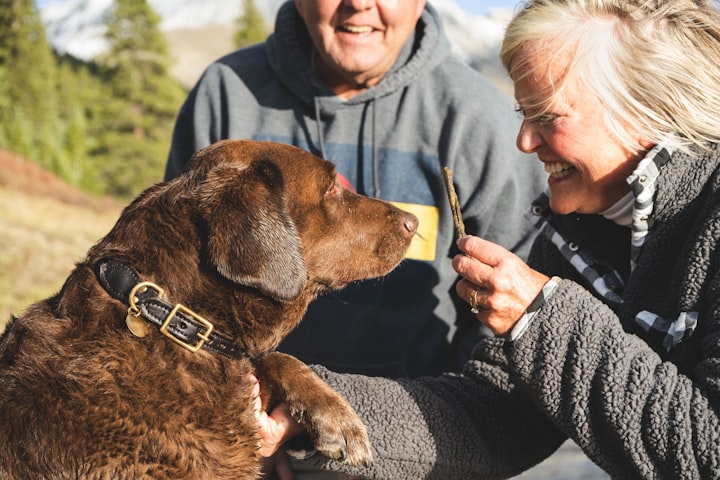Talk to Dogs: Understanding Canine Communication and Body Language
Dogs are amazing animals that can bring joy, companionship, and loyalty to our lives. As a pet owner, it's important to understand your dog's communication and body language to better connect with them and meet their needs. In this article, we will discuss how to talk to dogs, what their body language means, and how to train them effectively.
Understanding Dog Communication
Dogs communicate with each other and with us using a variety of signals such as vocalizations, body language, and scent marking. Here are some common ways dogs communicate: Click Here to dog speak
Vocalizations
Dogs use different types of barks, growls, and whines to communicate their feelings and intentions. For example:
High-pitched barks or whines may indicate excitement or anxiety
Low-pitched, continuous barks may indicate aggression or frustration
Growls can be a warning sign of aggression or a sign of playfulness, depending on the context
Body Language
Dogs use their body language to communicate their emotions and intentions. Here are some common body language signals and what they mean:
Tail wagging
Contrary to popular belief, tail wagging doesn't always mean a dog is happy. A slow, low wagging tail may indicate fear or uncertainty, while a high, fast wagging tail may indicate excitement.
A dog's ears can tell you a lot about how they're feeling. For example:
Relaxed ears indicate a calm, friendly dog
Pricked ears indicate alertness or excitement
Flattened ears indicate fear or submission
Eye contact
Direct eye contact can be seen as a threat in dog language. A relaxed, soft gaze indicates a friendly, non-threatening dog, while a hard stare may indicate aggression.
Training Your Dog
Training your dog is essential for creating a strong bond and a happy, well-behaved pet. Here are some tips for effective dog training:
Positive Reinforcement
Positive reinforcement means rewarding your dog for good behavior. This can be done with treats, praise, or toys. It's important to reward your dog immediately after they perform the desired behavior to reinforce the connection.
Consistency
Consistency is key when training your dog. Dogs thrive on routine and predictability, so it's important to establish clear rules and boundaries and stick to them.
Patience
Training your dog takes time and patience. Don't get frustrated if your dog doesn't learn a new behavior right away. Keep practicing and rewarding their progress.
Conclusion
Understanding your dog's communication and body language is crucial for building a strong relationship and meeting their needs. By learning how to talk to dogs and training them effectively, you can create a happy, healthy, and well-behaved pet.
FAQs
Can all dogs understand human language?
No, dogs don't understand human language like we do. However, they can learn to associate certain words or phrases with specific actions or behaviors.
How can I tell if my dog is happy?
A happy dog will have relaxed body language, wagging tail, and may pant or play.
Should I use punishment to train my dog?
No, punishment can be counterproductive and damage the trust and bond between you and your dog. Positive reinforcement is a more effective and humane way to train your dog.
Can dogs sense human emotions?
Yes, dogs can sense human emotions and may respond to them with their own body language and behavior.
Can I train an older dog?
Yes, dogs of all ages can be trained, but it may take longer for older dogs to learn new behaviors. Patience and consistency are key to success.Bonding with Your Dog
One of the best ways to talk to your dog is through bonding activities. These can include things like playing, grooming, and cuddling. Spending quality time with your dog can help build trust and strengthen your relationship. Some activities you can try include:
Playtime
Dogs love to play and it's a great way to bond with your pet. Try playing fetch, tug-of-war, or hide-and-seek with your dog. You can also use toys to keep your dog entertained and mentally stimulated.
Grooming
Grooming your dog can be a bonding experience for both you and your pet. Brushing, bathing, and clipping your dog's nails can help keep them healthy and clean, while also providing an opportunity for physical touch and bonding.
Cuddling
Many dogs love to snuggle and cuddle with their owners. This can be a great way to show affection and create a sense of security for your pet. Make sure to give your dog plenty of physical contact, such as petting or belly rubs, to help strengthen your bond.
Understanding Aggression
While most dogs are friendly and well-behaved, some may display aggressive behavior. It's important to understand the underlying causes of aggression and how to manage it. Here are some common causes of aggression in dogs:
Fear
Dogs may become aggressive when they feel threatened or scared. It's important to identify the source of your dog's fear and work to desensitize them to it through training and exposure.
Territoriality
Dogs are naturally territorial and may become aggressive when they feel their territory is being invaded. This can include their home, yard, or even their food or toys. It's important to establish clear boundaries and rules with your dog to prevent territorial aggression.
Dominance
Some dogs may display aggressive behavior as a way to assert their dominance over other dogs or humans. It's important to establish yourself as the pack leader through training and consistent rules and boundaries.
About the Creator
R Raja
Happy Life Happy Wealthness Enjoy....
More Bio Click here https://bit.ly/3G10YX0







Comments
There are no comments for this story
Be the first to respond and start the conversation.